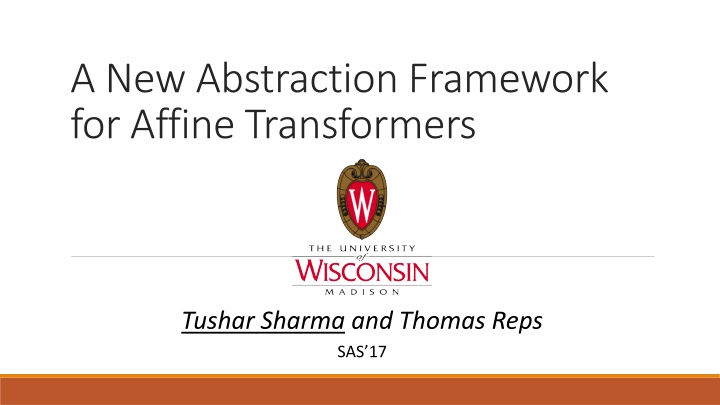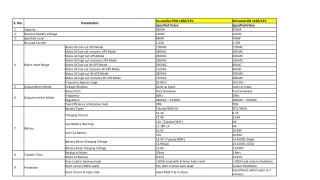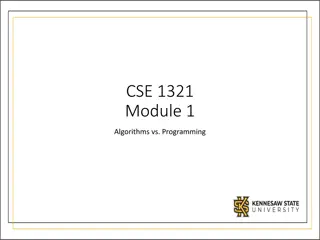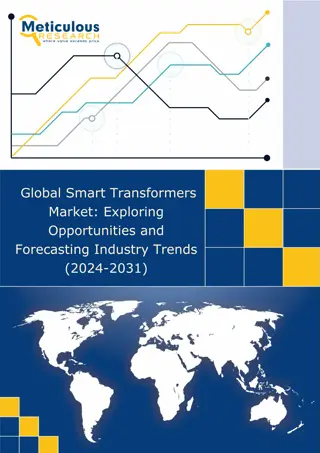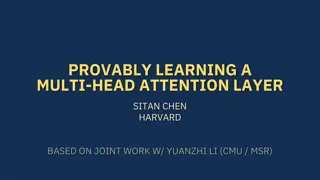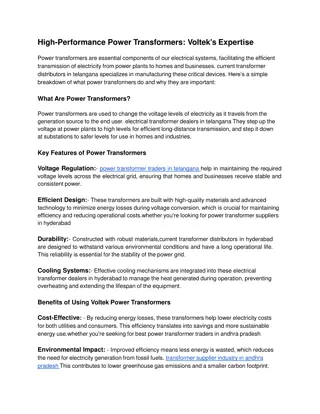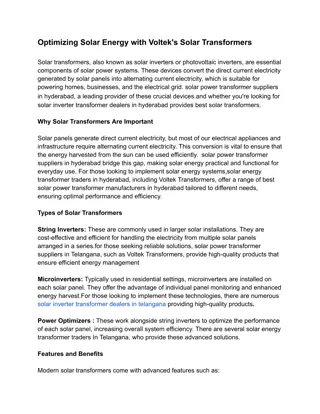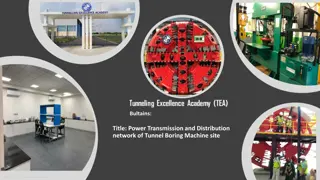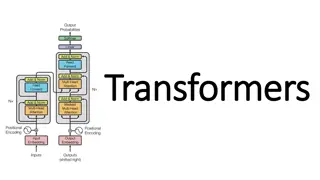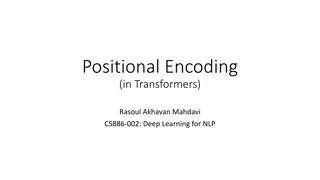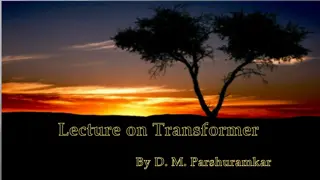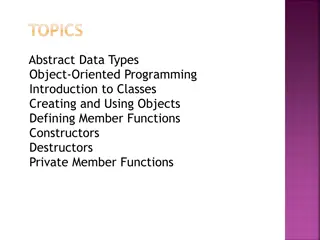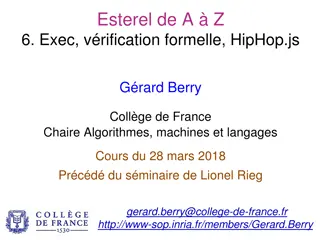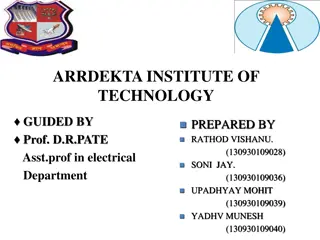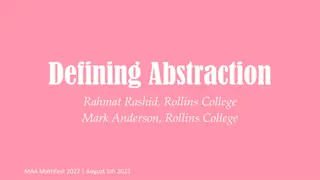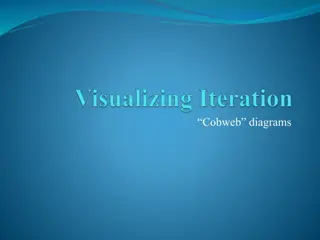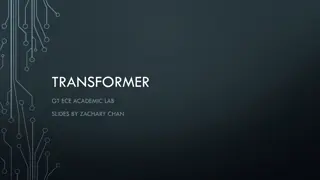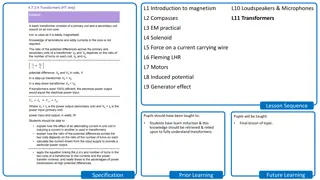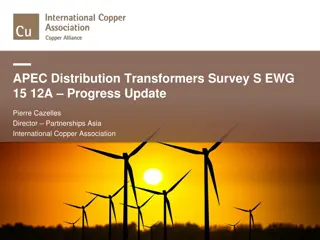Affine Transformers Abstraction Framework
This content introduces a new abstraction framework for affine transformers, exploring abstract domains and semantics to analyze program invariants. It discusses the motivations behind proving program assertions sound with respect to bitvectors and presents new abstract domains for disjunctions over affine transformers and bitvectors. The framework includes Affine Transformer Abstraction (ATA) and showcases examples of affine transformers. Background on abstract interpretation and program domains is also provided with a simple example program with a Parity Domain.
Download Presentation

Please find below an Image/Link to download the presentation.
The content on the website is provided AS IS for your information and personal use only. It may not be sold, licensed, or shared on other websites without obtaining consent from the author.If you encounter any issues during the download, it is possible that the publisher has removed the file from their server.
You are allowed to download the files provided on this website for personal or commercial use, subject to the condition that they are used lawfully. All files are the property of their respective owners.
The content on the website is provided AS IS for your information and personal use only. It may not be sold, licensed, or shared on other websites without obtaining consent from the author.
E N D
Presentation Transcript
A New Abstraction Framework for Affine Transformers Tushar Sharma and Thomas Reps SAS 17
Motivations Prove Program Assertions Function and loop summaries Sound with respect to bitvectors 2 A NEW ABSTRACTION FRAMEWORK FOR AFFINE TRANSFORMERS. T. SHARMA AND T. REPS. SAS'17
Affine Transformers Abstraction (ATA) Affine Transformer Abstraction Framework: ATA[B] Family of abstract domains Parametrized over a base domain B for bitvectors Repurposing ATA[B] B Abstraction over points Abstraction over affine transformers 3 A NEW ABSTRACTION FRAMEWORK FOR AFFINE TRANSFORMERS. T. SHARMA AND T. REPS. SAS'17
Affine Transformers Abstraction (ATA) New Abstract Domains not discussed previously in literature Can express interesting class of disjunctions over affine transformers over bitvectors: E.g.: Interval Affine Maps v1 = [1,7] v1 + [0,2] v2 + [3,4] vj and vj represent pre-transformation and post- transformation variables, respectively. E.g.: Octagon Constrained Affine Maps v1 = i1 . v1 + i2 . v2 , 0 i1 + i2 5 4 A NEW ABSTRACTION FRAMEWORK FOR AFFINE TRANSFORMERS. T. SHARMA AND T. REPS. SAS'17
Affine Transformer Affine Transformer: ? = ? C + ? [v1 v2 ] = [v1 v2 ]1 0 0 + [10 0], represents (v1 = 1v1 + 2v2+ 10) (v2 = 0) 2 All variables and coefficients are equal- width bitvectors (8,16,32,64) T = 1 d ? , [1 ? ] = [1 ?] T 0 1 0 0 10 1 2 0 0 0 Example: [1 v1 v2 ] = [1 v1 v2] If n = | ?|, then T is a n(n+1) matrix. 5 A NEW ABSTRACTION FRAMEWORK FOR AFFINE TRANSFORMERS. T. SHARMA AND T. REPS. SAS'17
Background: Abstract Interpretation Program Abstract Domain + Abstract Semantics Abstraction Fixpoint Analysis Program Invariants 6 A NEW ABSTRACTION FRAMEWORK FOR AFFINE TRANSFORMERS. T. SHARMA AND T. REPS. SAS'17
Background: Abstract Interpretation Simple example program with Parity Domain. {v: even} Abstraction at each node. L0 L0: L1: L2: L3: L4: v=v+1 } L5: print(1/v) // assert(v!=0) v=v+1 while(*) { v=v+2 } if(v%2==0) { {v: odd} L1 {v: odd} L2 {v: odd} L3 {v: } L4 {v: odd} L5 7 A NEW ABSTRACTION FRAMEWORK FOR AFFINE TRANSFORMERS. T. SHARMA AND T. REPS. SAS'17
Background: Abstract Interpretation Program Abstraction at Abstraction at each edge. each node. Abstract Domain + Abstract Semantics (Abstract Transformers) Abstraction Fixpoint Analysis Program Invariants 8 A NEW ABSTRACTION FRAMEWORK FOR AFFINE TRANSFORMERS. T. SHARMA AND T. REPS. SAS'17
Abstraction at each edge Start (Identity Transformation): (v,v ) { e,e , o,o } L0 L0: L1: L2: L3: L4: v=v+1 } L5: print(1/v) v=v+1 while(*) { v=v+2 } if(v%2==0) { (v,v ) { e,o , o,e } L1 (v,v ) (v,v ) { e,e , o,o } { e,e , o,o } L2 (v,v ) { e,e , o,o } Summary: (v,v ) { e,o , o,o ,(o,e)} L3 (v,v ) { e,e } (v,v ) { o,o } L4 (v,v ) { e,? , e,o } L5 9 A NEW ABSTRACTION FRAMEWORK FOR AFFINE TRANSFORMERS. T. SHARMA AND T. REPS. SAS'17
Background: Abstract Transformers Type A bool A A A A Operation Description Bottom element Equality (a1 == a2) (a1 a2) (a1? a2) Id Join Widen Identity Transformation (a1 a2) Compose = {} (Representing empty set of points) = least upper bound (Set union for parity domain) Start (Identity Transformation): (v,v ) { e,e , o,o } e,o , o,e e,o , o,e = e,e , o,o 10 A NEW ABSTRACTION FRAMEWORK FOR AFFINE TRANSFORMERS. T. SHARMA AND T. REPS. SAS'17
Background: Past Bit-Precise Equality Domains KS MOS Both KS and MOS elements can be used as abstract transformers 11 A NEW ABSTRACTION FRAMEWORK FOR AFFINE TRANSFORMERS. T. SHARMA AND T. REPS. SAS'17
KS Definition A. King and H. S ndergaard, CAV 2008 A matrix, where each row encodes a constraint Example: v In other words, (v-v ) is even. 1 = 0 231 -231 v 0 where, v and v are 32-bit values. 12 A NEW ABSTRACTION FRAMEWORK FOR AFFINE TRANSFORMERS. T. SHARMA AND T. REPS. SAS'17
MOS Definition M. Muller-Ohm and H. Seidl: Set of affine transformers A set of matrices, every affine combination those matrices may transform the initial state M1 M2 v = v+2p for some bitvector p. In other words, (v-v ) is even. Example: 0 1, means, 1 0 1 2 0 1 M = 1 2p 0 1 i: 1 v 1 v 13 A NEW ABSTRACTION FRAMEWORK FOR AFFINE TRANSFORMERS. T. SHARMA AND T. REPS. SAS'17
Bit-Vector Equality Domains KS: Conjunction of affine constraints Affine-closed set MOS: Affine-closed set of affine transformers 14 A NEW ABSTRACTION FRAMEWORK FOR AFFINE TRANSFORMERS. T. SHARMA AND T. REPS. SAS'17
Affine-Closed Set Affine-closed set = set of affine relations. An affine relation is a linear-equality constraint over bitvectors. Example: 2v1 + 7v2 + 3 = 0 S is an affine-closed set If p1 S, p2 S and k1 + k2 = 1 Then k1 p1 + k2 p2 S. 15 A NEW ABSTRACTION FRAMEWORK FOR AFFINE TRANSFORMERS. T. SHARMA AND T. REPS. SAS'17
KS versus MOS Incomparable KS can represent pre-condition guard, but MOS cannot: v = 2 v v 1 = 0 10-2 MOS cannot express v=2: no affine transformer exists 16 A NEW ABSTRACTION FRAMEWORK FOR AFFINE TRANSFORMERS. T. SHARMA AND T. REPS. SAS'17
KS versus MOS MOS can encode non-affine-closed relations, but KS cannot Consider MOS element M representing: p. v1 = v2 = v1 + p(v2 - v1) M = (v1 = v2 = v1) (v1 = v2 = v2) Elements a and b are in M, but their affine combination c is not. a = ?1 1 1 1 1 b = [2 -2 6 6] c = [0 0 -4 -4] (2a-b) ?2 ?1 ?2 17 A NEW ABSTRACTION FRAMEWORK FOR AFFINE TRANSFORMERS. T. SHARMA AND T. REPS. SAS'17
Why are KS and MOS incomparable? Why are KS and MOS incomparable? KS is affine-closed-set of concrete states . MOS is affine-closed-set of concrete affine transformers . KS defines constraints on the variables of a program, i.e. ? and ? (2n variables: n = |?|). However, MOS defines constraints on the elements of affine transformers T (n(n+1) coefficients). Generalize this behavior to create new abstract domains like MOS: ATA[KS] = MOS, ATA[??2?] = ? 18 A NEW ABSTRACTION FRAMEWORK FOR AFFINE TRANSFORMERS. T. SHARMA AND T. REPS. SAS'17
ATA Contributions Affine Transformer Abstraction Framework (ATA[B]) Parameter B allows control over precision/performance tradeoff Provide abstract-domain operations for ATA, such as Join and Abstract Composition 19 A NEW ABSTRACTION FRAMEWORK FOR AFFINE TRANSFORMERS. T. SHARMA AND T. REPS. SAS'17
Program Analysis using ATA[KS] ENT: int f(int x) { L0: int i = 0, r = 0; L1: while(i <= 10) { L2: if(*) L3: r = r + 2*x; L4: i = i + 1; } L5: return r; } Function Summary for f : i i:r :r = = 2ix 2ix Abstract Transformers for ATA[KS] 20 A NEW ABSTRACTION FRAMEWORK FOR AFFINE TRANSFORMERS. T. SHARMA AND T. REPS. SAS'17
Program Analysis using ATA[??2?] ENT: int f(int x) { L0: int i = 0, r = 0; L1: while(i <= 10) { L2: if(*) L3: r = r + 2*x; L4: i = i + 1; } L5: return r; } Function Summary for f : r r = = [0,20]x [0,20]x Abstract Transformers for ATA[??2?] 21 A NEW ABSTRACTION FRAMEWORK FOR AFFINE TRANSFORMERS. T. SHARMA AND T. REPS. SAS'17
A (ATA[B]) Abstract-Domain Operations Each element a A contains an element base(a) B. Type A bool A A A Operation Description B base(a1) == base(a2) base(a1) base(a2) ?(I) ? [0, 0] [1, 2] [0, 0] [0, 0] [0, 3] [1, 2] [1, 1] [0, 10] [0, 0] [0, 0] [1, 1] [0, 0] [0, 0] [0, 0] [1, 1] [1, 1] [5, 15] [0, 1] [0, 0] [2, 2] [0, 0] [0, 0] [1, 3] [1, 2] (a1 (a1 a2) Id (a1 a2) == a2) [1, 1] [0, 15] [0, 1] = 22 A NEW ABSTRACTION FRAMEWORK FOR AFFINE TRANSFORMERS. T. SHARMA AND T. REPS. SAS'17
Abstract Composition a3 = a2 a1 If affine transformer t1 (a1) and affine transformer t2 (a2), then (t1 t2) (a3). t1 and t2 are (n+1) (n+1) matrices. 23 A NEW ABSTRACTION FRAMEWORK FOR AFFINE TRANSFORMERS. T. SHARMA AND T. REPS. SAS'17
Best (but Nave) Solution Enumerate all concrete affine transformers t1 (a1), t2 (a2) Perform matrix multiplication (t1 t2 )of each such pair Join over all (t1 t2 ) Infeasible Better Solution: Represent (t1 t2 ) symbolically Non-linear components: t1 t2 24 A NEW ABSTRACTION FRAMEWORK FOR AFFINE TRANSFORMERS. T. SHARMA AND T. REPS. SAS'17
Abstract Composition General Solution (Symbolic Abstraction) Na ve Solution Generality Specific Solutions: 1) Non-Relational 2) Weakly-Convex Relational 3) Affine-Closed Relational Performance 25 A NEW ABSTRACTION FRAMEWORK FOR AFFINE TRANSFORMERS. T. SHARMA AND T. REPS. SAS'17
General Case Use Symbolic Abstraction Employ SMT solvers to cleverly search the space of the resulting abstract composition Offshore solving non-linear bitvector equations to the solver 26 A NEW ABSTRACTION FRAMEWORK FOR AFFINE TRANSFORMERS. T. SHARMA AND T. REPS. SAS'17
Abstract Composition via Symbolic Abstraction Symbolic Representation of matrix multiplication Uses blackbox learning over a lattice using SMT solvers. ? ? ? Abstract Transformer 27 A NEW ABSTRACTION FRAMEWORK FOR AFFINE TRANSFORMERS. T. SHARMA AND T. REPS. SAS'17
Special Case: Non Non- -relational relational Base Domain Use abstract addition and multiplication operations to perform abstract composition. [1, 1] [0, 10] [0, 0] [0, 0] [1, 1] [2, 3] [0, 0] [0, 0] [1, 1] [0, 0] [1, 3] [1, 1] [0, 0] [0, 0] [2, 4] [0, 0] [0, 0] [1, 2] = [1, 1] [0, 10] .# [2,4] [0, 0] [0, 0] ([1, 1] .# [2, 4]) +# ([2,3] .# [1, 3]) [0, 0] [1,1] .# [1, 3] [1, 1] .# [1, 2] [1, 1] [0, 40] [0, 0] [0, 0] [4, 13] [2, 6] [0, 0] [1, 3] [2,3] .# [1, 2] = [1, 2] 28 A NEW ABSTRACTION FRAMEWORK FOR AFFINE TRANSFORMERS. T. SHARMA AND T. REPS. SAS'17
Examples of Non-relational base domains Small sets (SSn): All sets with maximum cardinality n Intervals (??2?): [a,b] = {a, a+1, a+2, , b} Strided Intervals (S??2?): s[a,b] = {a, a+s, a+2s, , b} 29 A NEW ABSTRACTION FRAMEWORK FOR AFFINE TRANSFORMERS. T. SHARMA AND T. REPS. SAS'17
Special Cases of Relational base domains (Affine-Closed, Weakly-Convex) Base Domains Use the generator representation. a1 = Gen({r1, r2 , , rn1}), a2 = Gen({s1, s2 , , sn2}). ri, sj are affine transformers ((n+1) (n+1) matrices) s2 r3 r2 a1 r1 r4 a2 s1 s3 r6 r5 30 A NEW ABSTRACTION FRAMEWORK FOR AFFINE TRANSFORMERS. T. SHARMA AND T. REPS. SAS'17
Special Cases of Relational base domains Matrix multiplication over generators is sufficient (no SMT calls). a3 = Gen({r1 s1 , , r1 sn2, r2 s1, , rn1 sn2 }) r1 s2 r3 s2 a3 = a2 a1 r1 s1 r6 s3 31 A NEW ABSTRACTION FRAMEWORK FOR AFFINE TRANSFORMERS. T. SHARMA AND T. REPS. SAS'17
Examples of base relational domains KS Domain: Affine Relations Bit-Vector Sound versions of Polyhedra Octagons 32 A NEW ABSTRACTION FRAMEWORK FOR AFFINE TRANSFORMERS. T. SHARMA AND T. REPS. SAS'17
Discussion: No Greatest Lower bound in ATA[B] v = v v The best affine transformer abstracting any single point does not exist. (0,0) v v = -v 33 A NEW ABSTRACTION FRAMEWORK FOR AFFINE TRANSFORMERS. T. SHARMA AND T. REPS. SAS'17
Discussion No Galois Connection between ATA[B] and the concrete domain C (powerset over concrete states). Greatest upper bound does not exist for ATA[B], and, in general Least Upper Bound Operation does not exist either. Multiple incomparable ways to abstract assumes Example: assume(x<=5) withATA[??2?] x = [1,1]x + [0,0] x = [0,0]x + [0,5] 34/50 A NEW ABSTRACTION FRAMEWORK FOR AFFINE TRANSFORMERS. T. SHARMA AND T. REPS. SAS'17
Recap Introduced a generic framework of abstract domains: ATA[B]. Parameter B allows control over precision/performance tradeoff. B and ATA[B] are, in general, incomparable. Fast abstract composition for some classes of B: Non-relational Domains Affine-closed or Weakly Convex Relational Domains ATA framework can be extended to integers and rationals as well. 35 A NEW ABSTRACTION FRAMEWORK FOR AFFINE TRANSFORMERS. T. SHARMA AND T. REPS. SAS'17
Questions? Affine Transformer Abstraction Framework: ATA[B] Family of abstract domains Parametrized over a base domain B for bitvectors Repurposing ATA[B] B Abstraction over points Abstraction over affine transformers 36 A NEW ABSTRACTION FRAMEWORK FOR AFFINE TRANSFORMERS. T. SHARMA AND T. REPS. SAS'17
